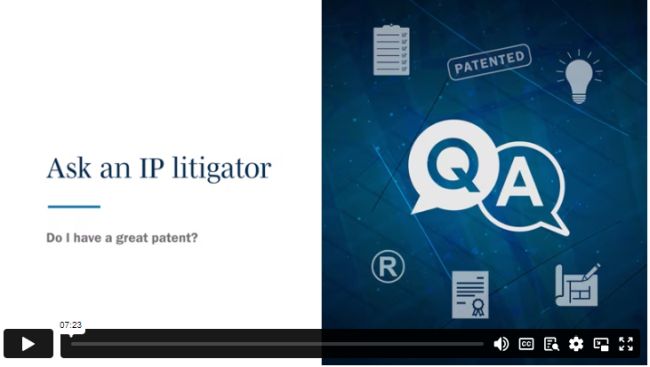Video transcript
Andrew Shaughnessy (00:05): Patents. They offer a period of exclusivity for 20 years in exchange for what our courts like to call the quid pro quo of disclosing something new, useful and inventive to the public. A strong patent system is said to incentivize innovation, yet, as Alex and I know all too well, patents are often invalidated. Which begs the question in every case: Is my patent any good?
I'm Andy Shaughnessy, and I'm here with Alex Peterson to answer this question.
Alexandra Peterson (00:34): So, there are certain criteria that an invention has to have to become patentable. We can think of these as sort of the three pillars of patentability. So first of all, your invention has to be for something new, it must be novel. Second, it must have utility, it has to be useful for something. And lastly, it can't be for something obvious, it has to be inventive.
In Canada, a patent application is reviewed by an examiner and the examiner has to do their own search for any relevant art that relates to the patent, to assess whether it is indeed for something new and inventive or ask the patentee to produce it. In the U.S., the applicant is required to provide the relevant prior art that relates to the patent.
And in addition to looking at novelty and obviousness issues, examiners will also review the patent application for formalities like enablement. Do the claims that you have put in your patent cover the subject matter that you've actually disclosed? Sufficiency—does your patent document explain what the invention is among other questions?
And this patent application process is just between the examiner and the patentee. Third parties are not involved. So, in litigation, when a third party gets involved, the patent's validity often gets a much harder shake. Which means that just because a patent has been granted, that may ultimately become insignificant when the patent gets attacked later on.
Andrew Shaughnessy (02:04): And when it comes to enforcing a patent. One of the first questions we're asked is: Will this patent give me exclusivity out to the end of its term? This is what we call "LOE" or "loss of exclusivity". And that question is really another way of asking: What is the likelihood of success that I will win on this patent?
And I find this an interesting question because in the litigation context, our outcomes are binary. We win or we lose. The patent is upheld and it's good, or it's taken down and it's bad. But what if we say that the likelihood that a patent will be successfully maintained is, I don't know, 60%? How does that translate into a binary world?
Well, in practical terms, that might suggest that if I can get the client out to 60% of their LOE date, i.e., that's the loss of exclusivity date, if I get 60% of that period with a settlement, that could be a good thing. Of course, if the client doesn't settle, then we're looking at throwing our hat into the binary ring of litigation.
And in either event, it's good to get a sense of how good the patent is. And, Alex, why don't you take us through the types of things that we look at pre-litigation and answering the question of whether or not a patent is good?
Alexandra Peterson (03:15): So, the first thing we would want to do is make sure that there's an infringement position. Because if there's no infringement then the patents not engaged. Typically, we'll pull the file history to make sure that any infringement position we might assert is consistent with positions taken by the patentee in the course of prosecution of the patent.
This will typically be looking at the Canadian file history, but it can also involve looking at other prosecution histories for foreign equivalent patents. We also study the prior art that was cited in the prosecution of the patent, both in Canada and other prior art that may have been cited in the U.S. and the E.U., especially if the patent has been challenged in a European opposition.
We may ask for a prior art search to be conducted, to make sure that nothing was missed by any of the examiners, and we ask the question: What are the weaknesses with this patent? If we have time, we may also ask to interview the inventor or inventors of a patent because, believe it or not, the invention story can make a big difference when the case goes to court.
Andrew Shaughnessy (04:17): This sounds like it has the potential to get quite expensive.
Alexandra Peterson (04:20): It can be, but not when you compare it to the cost of litigation. And that's a point worth considering. If you can't afford to take a patent to trial, that suggests that settlement should be a preferred outcome. That said, there are ways of managing costs. Things like seeking a preliminary injunction to restrain the defendant, or splitting and proceeding to have issues of infringement and validity determined separately from questions of monetary damages.
Sometimes clients will ask about a preliminary injunction. However, these are generally hard to get and rarely granted. The reason being that the test for an injunction requires the parties seeking it to demonstrate that they will suffer irreparable harm if the injunction is denied. And that's a very difficult test to satisfy. Not only that, but the moving party, the person seeking the injunction, also typically has to give an undertaking as to damages, meaning they have to undertake to compensate the enjoined party.
The party who is resisting the injunction to compensate that party for the period of time that they are kept off the market. So, patents can be complicated and onerous things to litigate, which is all the more reason to have a clear understanding of the patent's strengths at the outset. Gone are the days when we can wave a patent around and not fully understand its strengths and weaknesses.
Andrew Shaughnessy (05:39): And it's worth pointing out that we have to do this even when the patent has been challenged in Europe or let's say, the United States. Even if the patent has been invalidated and there's no longer on the books in those countries or those jurisdictions, or even where the patentee has won, patent laws are geographic in scope, and while results in other jurisdictions may be interesting or add optical value, a Canadian patent has to be assessed on its own merits.
And if a patent does get past the courtroom door, it'll be assessed by a judge who may or may not have rather a technical background, or may not have the technical background of the patent in question. So, very often we have to do the analysis with the layperson in mind, the lay judge. So, Alex, can any of this process be shortcutted?
Alexandra Peterson (06:26): Yes, patents can be asserted without this work being done, but it's something of a bluff. The other side will then do the work and should be able to assess the merits of the patent, which will either drive settlement or litigation. But if they do the work and you don't, then you won't be on equal footing. The better approach is to do the work upfront, maybe even during the prosecution phase, to make sure that there is a narrower claim that can be easily asserted and defended.
Then, if litigation follows, the process can be used as a tool to lever the parties toward settlement. Or if you think you have a great patent and your legal counsel thinks you have a strong case, take it to trial.
Andrew Shaughnessy (07:04): As we said, patents are valuable tools for coaxing inventions into the public domain. But a patent's strength is the key determinant in whether it will have this value, which is why we ask the question: Do I have a great patent?
Patents provide a period of exclusivity, offer incentives to inventors and spur innovation. However, they are often invalidated.
In this video, Andy Shaughnessy and Alex Peterson, share insights to determine the strength of a patent including:
- The three pillars of patentability
- What patent examiners look for
- Enforceability questions
Click here to see other videos in this series.
The content of this article is intended to provide a general guide to the subject matter. Specialist advice should be sought about your specific circumstances.



